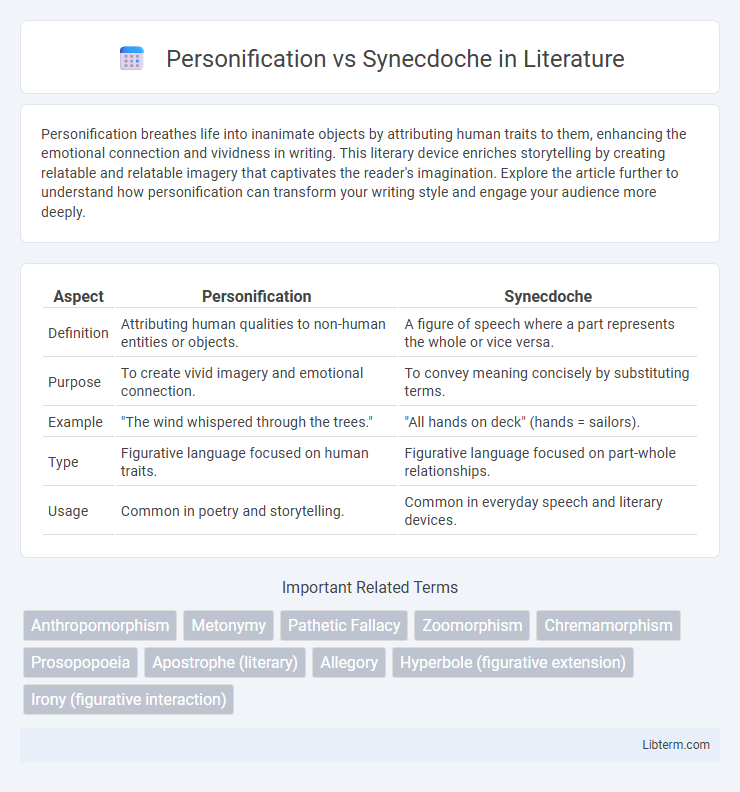Personification breathes life into inanimate objects by attributing human traits to them, enhancing the emotional connection and vividness in writing. This literary device enriches storytelling by creating relatable and relatable imagery that captivates the reader's imagination. Explore the article further to understand how personification can transform your writing style and engage your audience more deeply.
Table of Comparison
| Aspect | Personification | Synecdoche |
|---|---|---|
| Definition | Attributing human qualities to non-human entities or objects. | A figure of speech where a part represents the whole or vice versa. |
| Purpose | To create vivid imagery and emotional connection. | To convey meaning concisely by substituting terms. |
| Example | "The wind whispered through the trees." | "All hands on deck" (hands = sailors). |
| Type | Figurative language focused on human traits. | Figurative language focused on part-whole relationships. |
| Usage | Common in poetry and storytelling. | Common in everyday speech and literary devices. |
Introduction to Personification and Synecdoche
Personification attributes human qualities to animals, objects, or abstract ideas, enhancing imagery and emotional connection in literature. Synecdoche is a figure of speech where a part represents the whole or vice versa, creating concise and impactful expressions. Both devices enrich language by imbuing abstract concepts and elements with vivid, relatable meaning.
Defining Personification
Personification is a literary device where human qualities, emotions, or actions are attributed to non-human entities, such as animals, objects, or abstract concepts, enhancing vividness and emotional connection in writing. Unlike synecdoche, which involves using a part to represent the whole or vice versa, personification specifically animates inanimate subjects by giving them lifelike characteristics. This technique is commonly employed in poetry and prose to create relatable imagery and deepen thematic resonance.
Understanding Synecdoche
Synecdoche is a figure of speech where a part represents the whole or the whole represents a part, enhancing vivid imagery and deeper meaning in language. Unlike personification, which attributes human characteristics to non-human entities, synecdoche relies on a specific relationship between the component and the entirety. Understanding synecdoche involves recognizing examples such as "all hands on deck," where "hands" signify sailors, revealing its powerful role in concise and impactful expression.
Key Differences Between Personification and Synecdoche
Personification attributes human qualities to non-human objects or abstract ideas, enhancing emotional connection and imagery in literature. Synecdoche involves using a part of something to represent the whole or vice versa, creating concise and impactful expressions. The key difference lies in personification's focus on human traits versus synecdoche's emphasis on part-whole relationships.
Examples of Personification in Literature
In literature, personification animates inanimate objects or abstract ideas by attributing human characteristics, such as in William Wordsworth's "The daffodils," where flowers are described as "dancing" to evoke vivid imagery. In contrast, synecdoche uses a part to represent the whole or vice versa, exemplified by Shakespeare's use of "All hands on deck" to signify sailors. Personification enhances emotional connections by bringing nature and objects to life, creating immersive literary experiences.
Examples of Synecdoche in Literature
Synecdoche, a figure of speech where a part represents the whole or vice versa, appears frequently in literature, such as in Shakespeare's "Julius Caesar" when "Lend me your ears" symbolizes paying attention. Another notable example is in George Orwell's "Animal Farm," where "boots" represent the oppressive military force. These instances demonstrate how synecdoche enriches storytelling by using specific parts to evoke broader concepts.
The Role of Personification in Storytelling
Personification breathes life into storytelling by attributing human qualities to animals, objects, or abstract ideas, making narratives more relatable and emotionally engaging for readers. This literary device enhances thematic depth and character development by enabling audiences to connect with non-human elements on a personal level. Unlike synecdoche, which uses part-whole relationships to represent concepts, personification focuses on embodying emotions and intentions through human traits to enrich storytelling.
The Function of Synecdoche in Communication
Synecdoche functions as a powerful rhetorical device by using a part of something to represent the whole, thus creating concise and impactful communication. This figure of speech enhances clarity and vividness by enabling audiences to quickly grasp complex concepts through familiar elements. Unlike personification, which attributes human qualities to inanimate objects, synecdoche ground messages in tangible, relatable details that strengthen understanding and retention.
When to Use Personification vs Synecdoche
Personification is used when assigning human traits to non-human objects or abstract ideas to evoke empathy and vivid imagery, making concepts more relatable and engaging. Synecdoche involves using a part to represent the whole or vice versa, ideal for emphasizing key details or conveying complex ideas succinctly in literature and communication. Choose personification to animate and breathe life into descriptions, while synecdoche excels at highlighting specific elements to encapsulate broader meanings.
Conclusion: Enhancing Writing with Figurative Language
Personification and synecdoche both enrich writing by adding vivid imagery and deeper meaning, with personification attributing human qualities to non-human elements, and synecdoche using a part to represent the whole or vice versa. Mastering these figurative language techniques enhances narrative engagement and clarifies complex ideas, making descriptions more relatable and memorable. Writers who skillfully apply personification and synecdoche can create more compelling, imaginative, and impactful texts that resonate strongly with readers.
Personification Infographic

 libterm.com
libterm.com